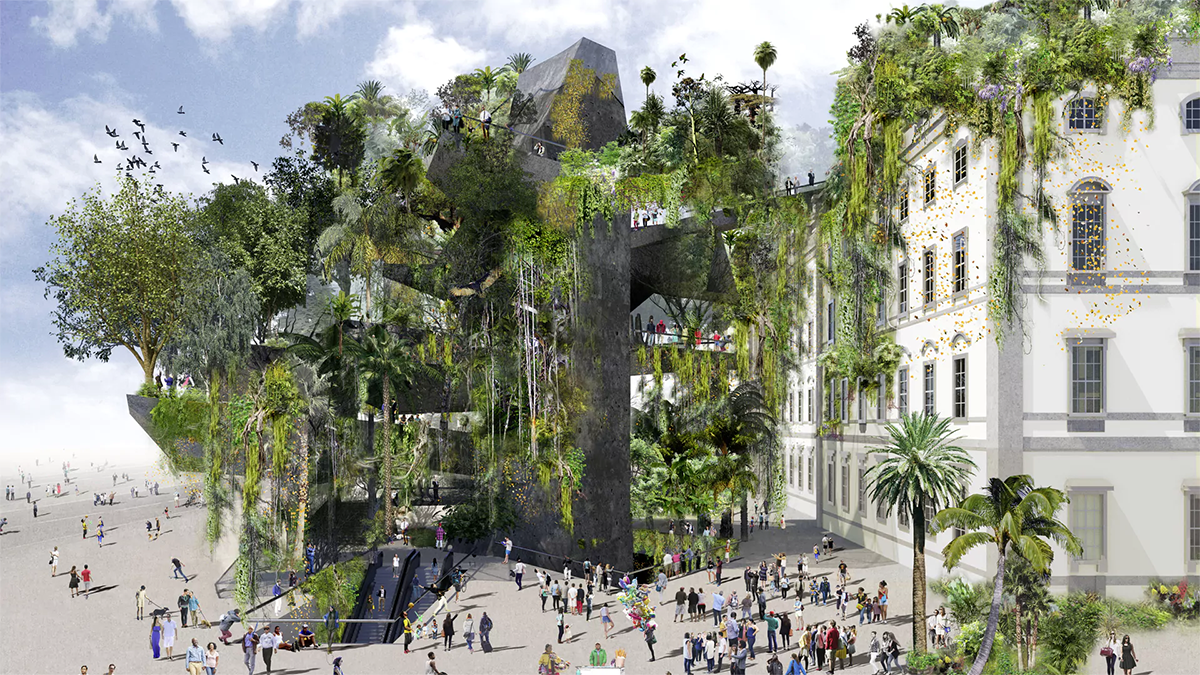In Deutsche Bauzeitung the author Bernhard Schulz, who is editor of the culture edition of Tagesspiegel Berlin published an article on the reconstruction of the Berlin City Palace.
The article refers to Humboldt Volcano.
Article Fake Architecture, Bernhard Schulz @ DB Deutsche Bauzeitung, Germany, 1 September 2017
The contrast is irresolvable: here reconstruction fans who want to intoxicate themselves, so to speak, with built fake news, there those who lament the absurdity therein. Bernhard Schulz rejoices that Berlin has something to offer everyone.
Tens of thousands recently took advantage of the two Open Days at the Berlin Palace-with-Humboldt-Forum to roam the first floor of the future passage that will, in a sense, divide the building, and the glass-covered Small Palace Courtyard that will form the event center, the “agora” of the Humboldt Forum. One was taken with the carefully crafted, sandstone-colored precast concrete elements that Franco Stella’s rationalist design arranges into whole rows of circular pillars, and which indeed blend excellently with the reconstructed parts. For example, with the magnificent Baroque portal on the inside of the Small Palace Courtyard, this Roman triumphal arch, on which two allegories of Fama announce royal glory, one in the future with a gilded trombone and the other, oh miracle, the original rescued from some rubble, albeit damaged and no longer capable of blowing the trombone for lack of a hand. But Berlin is happy about every piece of rubble that attests to the former existence of the castle.
However, many people still have reservations about the castle, whether it is old or new. These days, the Berlin Senate Building Director had the correspondent of the Stuttgarter Zeitung as a guest in her office, on the 14th floor of the Senate Building Administration. And up there, where one can let the view sweep over Berlin, as one reverently noted, there escaped the Swiss-born Regula Lüscher the sentence, she sees “the danger that the reconstruction tips over into the Disney-like”. What you say when you don’t make a pit of murder out of your heart; and the nice thing about Ms. Lüscher is that, despite her fine, reserved manner, she certainly doesn’t make a pit of murder out of her heart. She has let it be known often enough that she doesn’t like the palace reconstruction – modern on the inside, baroque on the outside, concrete on the inside, brick on the outside – but the fact that she is now starting a scuffle over, of all things, the rooftop garden restaurant, which after all was approved by the Bundestag in 2015 and endowed with five extra million euros, must be due to the relaxed mood of a summer day in the office.
The head of the castle building foundation – it is the formal building owner and will be dissolved after completion -, Johannes Wien, countered coolly: “The restaurant is a done deal. It will be co-planned and co-constructed.” With it the thing is settled. What is not settled is the stalling resistance that Lüscher is putting up against the castle. She stubbornly resists the idea of putting Reinhold Begas’ famous Neptune Fountain – late 19th-century neo-Baroque, by the way – which stood on Schlossplatz and was moved to the vacated area in front of Berlin City Hall during GDR times, back in its historic location. The two life-size horse tamers from 1843, which stood on the Lustgarten side of the palace and wandered in front of the Allied Control Council at Kleistpark after the end of the war, are to remain where chance took them.
No, Lüscher will not be accused of a love of history. Thus, on the aforementioned side of the Lustgarten, which for decades has been the scene of traffic noise on the multilane street connection between Unter den Linden and Liebknechtstraße/Alexanderplatz, there will at best be a sparse small paving, by no means the garden terrace that the “Lustgarten” retains in its name and which is so magnificently bordered by Schinkel’s Altes Museum. Towards this side, which in the future will be perceived as the main facade of the palace, a piece of finished plastered palace facade is now already peeking out – in bright yellow, which was the very first color that could be determined by examining rubble found in remote piles of rubble. The yellow takes some getting used to, and only time will tell whether it harmonizes with the light Saxon sandstone from which the immaculate window jambs and pediments and the wall panels below the cornice, studded with merrily gazing Prussian eagles, are formed. Finally, one has also become accustomed to the delicate pink of the armory on the other side of the Spree arm called Kupfergraben, and the fact that this also appears opposite the now almost completed State Opera House will surely soon be sold by resourceful “city guides” as an example of Baroque harmony.
The State Opera, to be correct, is imitated baroque of the early GDR. The exterior of the Zeughaus is indeed original; the palace, on the other hand, is a complete replica. It’s strange that Berlin, which always prides itself on its 1920s modernity, now looks baroque in the city center. After all, it is a Baroque of capital city proportions. So large that it can easily accommodate a rooftop garden restaurant. And if that turns your stomach, you can visit a modern café on the east side of the castle under Franco Stella’s rationalist grid facade. There is something for every taste.
Rüdiger Schaper argues in the Tagesspiegel for a fundamental rethinking of the use of the Humboldt Forum:
Make way for the jungle
And the Hybrid Space Lab has long suggested breaking the unfortunate facade spell with design and functions that are fun:
Humboldt Volcano
related PROJECTS
related PRESS
